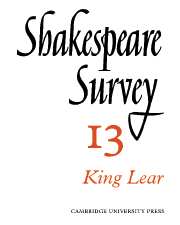Book contents
- Frontmatter
- The Catharsis of King Lear
- Lear’s Last Speech
- Albany
- Madness in King Lear
- The Influence of Gorboduc on King Lear
- Some Aspects of the Style of King Lear
- Keats and King Lear
- King Lear on the Stage: A Producer’s Reflections
- Costume in King Lear
- The Marriage-Contracts in Measure for Measure
- Tom Skelton—A Seventeenth-century Jester
- Illustrations of Social Life III: Street-Cries
- An Elizabethan Stage Drawing?
- Was there a Music-room in Shakespeare’s Globe?
- International Notes
- Shakespeare Productions in the United Kingdom: 1958
- Three Adaptations
- The Year's Contributions to Shakespearian Study 1 Critical Studies
- 2 Shakespeare’s Life, Times and Stage
- 3 Textual Studies
- Books Received
- Index
- Plate Section
Madness in King Lear
Published online by Cambridge University Press: 28 March 2007
- Frontmatter
- The Catharsis of King Lear
- Lear’s Last Speech
- Albany
- Madness in King Lear
- The Influence of Gorboduc on King Lear
- Some Aspects of the Style of King Lear
- Keats and King Lear
- King Lear on the Stage: A Producer’s Reflections
- Costume in King Lear
- The Marriage-Contracts in Measure for Measure
- Tom Skelton—A Seventeenth-century Jester
- Illustrations of Social Life III: Street-Cries
- An Elizabethan Stage Drawing?
- Was there a Music-room in Shakespeare’s Globe?
- International Notes
- Shakespeare Productions in the United Kingdom: 1958
- Three Adaptations
- The Year's Contributions to Shakespearian Study 1 Critical Studies
- 2 Shakespeare’s Life, Times and Stage
- 3 Textual Studies
- Books Received
- Index
- Plate Section
Summary
Shakespeare has many portraits of madness, real and assumed, and he returned to the theme again and again. Dr Pinch tries to exorcise Antipholus of Ephesus; Titus Andronicus is driven mad by his sufferings; Feste, disguised as Sir Topaz, pretends to exorcise Malvolio; Hamlet, unbalanced as he is, feigns madness, and Ophelia is driven mad by grief; Constance is driven distracted by her loss of Arthur; Portia, and perhaps Lady Macbeth, commit suicide while of unsound mind; and in The Tempest the three men of sin are maddened by the workings of conscience, so that their brains are as useless as a tumour. It says much for Shakespeare’s powers of observation or for his intuitive understanding of the human mind that his depiction of madness, though based no doubt on sixteenth-century theory, has satisfied medical opinion of later ages. J. C. Bucknill in his Remarks on the Medical Knowledge of Shakespeare (1860) and H. Somerville in Madness in Shakespearian Tragedy (1929) illustrate the fact that our increasing knowledge of madness during the past century has served only to justify Shakespeare’s intuitions. Ella Freeman Sharpe, indeed, was so impressed by the depiction of Lear’s madness that in her Collected Papers on Psycho-Analysis (1950) she argued that the play reflected the traumatic experiences of Shakespeare himself and that ‘psychically he regressed to the loves and hates of early childhood’, re-enacting his infantile desire not to share his mother’s love either with her husband or with other children. This theory is worth referring to, not because it is anything but wildly improbable, but because it shows that the madness depicted in the play has not been rendered false by the passage of time.
- Type
- Chapter
- Information
- Shakespeare Survey , pp. 30 - 40Publisher: Cambridge University PressPrint publication year: 1960

